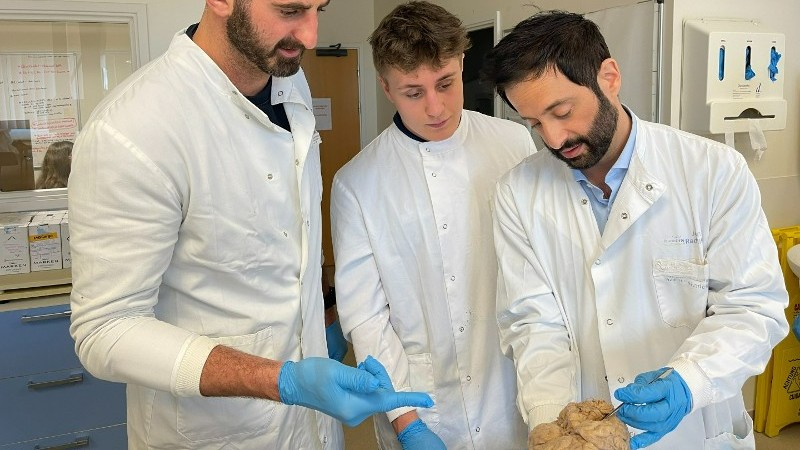Repeated head impacts are a definitive cause of CTE, breakthrough research reveals

New analysis by world-leading experts on chronic traumatic encephalopathy (CTE), has found conclusive evidence that repetitive head impacts (RHI) cause the degenerative brain disease CTE.
Analysis from the Concussion Legacy Foundation and researchers from Oxford Brookes University and 12 other academic institutions has determined a causal link between repeated head impacts and Chronic Traumatic Encephalopathy.
The international team of experts is issuing a global call to action to sports organisations, government officials, parents, and the military to immediately implement CTE prevention and mitigation efforts, especially for children.
The researchers analysed the data through the “Bradford Hill criteria”, a trusted set of nine benchmarks developed by one of the pioneers of smoking and lung cancer research to gauge the confidence science can place in a causal relationship between an environmental exposure and an adverse health outcome.
Among the revelations in the analysis, the authors discovered that the brain banks of the US Department of Defence, Boston University-US Department of Veterans Affairs, and Mayo Clinic have all published independent studies on distinct populations showing that contact sport athletes were at least 68 times more likely to develop CTE than those who did not play contact sports. This incredible strength of association, combined with robust evidence in all nine categories, is conclusive evidence linking repeated head impacts and CTE (chronic traumatic encephalopathy).
“This innovative analysis gives us the highest scientific confidence that repeated head impacts cause CTE,” said study lead author Dr. Chris Nowinski, Concussion Legacy Foundation CEO.
“Sport governing bodies should acknowledge that head impacts cause CTE and they should not mislead the public on CTE causation while athletes die, and families are destroyed, by this terrible disease.”
The most studied causes of CTE are contact and collision sports like football, rugby, American football, Canadian football, and Australian football. The study authors are concerned that parents and coaches, who have the most control over whether children are exposed to repetitive head impacts, are not getting the facts from global sports organisations, and their children are being exposed to preventable cases of CTE.
Sport needs to acknowledge causal link
The Football Association recently introduced a trial ban on heading until age 12 as a meaningful attempt at preventing repetitive head impacts in the youth population. Recent research however, has found that nearly three-quarters of boys are compelled to participate in contact rugby in secondary school physical education.
While both the United States Centers for Disease Control and Prevention and the National Football League (NFL) acknowledge a causal relationship between repetitive head impacts and CTE, global sporting organisations including Fédération Internationale de Football Association (FIFA), World Rugby, International Olympic Committee (IOC), National Hockey League, Canadian Football League, National Collegiate Athletic Association, Australian Football League, National Rugby League and New Zealand Rugby have not publicly acknowledged a causal relationship. Experts say it is the duty of these organisations to inform their athletes and their families and take appropriate steps toward CTE prevention and mitigation in light of this recent research.
Dr Adam J White, Senior Lecturer in Sport and Coaching Sciences at Oxford Brookes University and Executive Director of the Concussion Legacy Foundation UK said: “This analysis shows it is time to include repetitive head impacts and CTE among other child safety efforts like smoking, sunburns, and alcohol.
“Repetitive head impacts and CTE deserve recognition in the global public health discussion of preventable disorders caused by childhood exposure in contact sports like football, rugby, ice hockey and others.”
“Even we were surprised how strong the causal relationship is between repetitive head impacts and CTE becomes when the data are analysed with the appropriate framework and in an unbiased manner,” said study co-senior author Dr. Robert Cantu, medical director of the Concussion Legacy Foundation. “All of the coauthors have agreed we will retire the word association and begin using causation in any and all forums in an urgent effort to educate the public.”
In England, The Football Association recently introduced a trial ban on heading until age 12 as a meaningful attempt at preventing repetitive head impacts in the youth population. Recent research however, has found that nearly three-quarters of boys are compelled to participate in contact rugby in secondary school physical education.
True extent of CTE still unknown, but disease prevention urgently needed
“CTE can only be definitively diagnosed through a post-mortem examination of the brain,” continues Dr White. “We don’t yet know how many athletes, military veterans, and others exposed to head impacts have CTE, but nearly 1,000 cases have been diagnosed in the last decade. Knowing the exact prevalence of a disease is not required to enact disease prevention efforts, as we have seen in the cases of smoking, seat-belts and sunburn.”
The authors urge governments to support prevention efforts and research on CTE particularly as it is associated with developing early-onset dementia, which comes with extraordinary healthcare costs.
View the research paper, Applying the Bradford Hill Criteria for Causation to Repetitive Head Impacts and Chronic Traumatic Encephalopathy, is published in Frontiers in Neurology.
